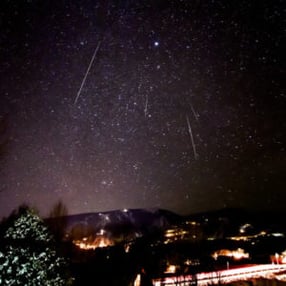
Have you ever gazed into the sky on a crisp Colorado night? This winter can be the perfect time to go out and test your knowledge of the night sky. Here in the Eagle Valley, our numerous sunny days also bring crisp, clear nights perfect for stargazing. The shorter days in the winter also mean that you don’t need to stay up late to experience the darkest skies and most vivid stars.
For the best star gazing, go close to a new moon. New moons occur at the point in the moon’s orbit when it is directly between the Earth and the Sun. The side of the moon that faces the Sun is illuminated, and the side facing earth is dark. Because of this, the sky is darkest on the new moon and the stars and constellations are at their most magnificent. This winter season, new moons will be occurring on January 13th, February 11th, and March 13th.
The most prominent winter constellations in Eagle Valley are Auriga, Canis Major, Canis Minor, Eridanus, Gemini, Monoceros, Orion the Hunter, and Taurus. Within these constellations are some of the brightest stars in the Milky Way galaxy. The brightest star in the sky, Sirius, is found by following the line made by the three stars of Orion’s belt easterly to Canis Major. Following that line westerly you will find Aldebaran, which is the brightest star in the Taurus constellation.
Also visible on dark nights is the brightest nebulae in the sky, the Orion Nebula. Nebulae, like the aforementioned one, are clouds of gas and dust, and are the birthplaces of stars. Stars are burning, luminous balls of gas held together by their own gravity. The heat and light that stars emit is caused by nuclear fusion occurring deep in the star’s core.
While new moons provide the darkest skies for stargazing, full moons offer a different, but equally enchanting nighttime experience. The first one of the year, also known as the Wolf Moon, is on January 28th. Full moons occur roughly every 29 days, so if you miss January’s check back on February 27th!
For the best nighttime viewing experience, both for full moons and star gazing, find a spot away from city lights. Light pollution, even from small towns such as ours, can impact your experience, as their light pollution decreases star visibility. Colorado is home to four certified International Dark Sky Communities: Norwood, Ridgway, Westcliffe, and Silver Cliff. If you decide to visit the Wet Mountain Valley, home to Westcliffe and Silver Cliff, your stargazing trip would not be complete without going to the Smokey Jack Observatory. Additionally, Black Canyon of the Gunnison National Park is a certified Dark Sky Park that will be sure to provide you with some of the best stargazing in the state.
Wherever you find yourself in the coming months, take a moment and step outside on a clear night. In the night sky, you can always find something new.

Kayla Steinmetz was a summer naturalist at Walking Mountains Science Center. She loves spending time outdoors and stargazing on mountain tops.
https://www.timeanddate.com/astronomy/sights-to-see.html
https://www.constellation-guide.com/seasonal-constellations/winter-constellations/
https://skyserver.sdss.org/dr1/en/astro/stars/stars.asp
https://spacetourismguide.com/stargazing-colorado/
https://www.lpi.usra.edu/education/skytellers/moon-phases/#:~:text=We%20have%20a%20%E2%80%9Cnew%20Moon,is%20facing%20away%20from%20Earth.








